Report on Quality Management Strategies for Rose and Crown Hotel
VerifiedAdded on 2019/12/28
|16
|5068
|214
Report
AI Summary
This report provides a comprehensive analysis of quality management principles within the context of the Rose and Crown Hotel, a 3-star establishment facing declining sales and customer complaints. The report defines quality, distinguishing between business and service quality, and explores quality control and assurance methods. It examines approaches for improving quality management, including TQM, process, and Dr. Feigenbaum's methods, while also comparing their similarities and differences. The report delves into customer satisfaction, emphasizing its role in revenue generation and loyalty, and discusses continuous improvement strategies based on Kaizen and Deming's approaches. Furthermore, it explores the importance of customer feedback, measuring satisfaction through surveys and consultations, and identifying the value of complaint procedures. The report concludes by addressing self-assessment, the significance of communication and record-keeping, staff consultation, and systems for improving service quality within the hotel, offering valuable insights for hospitality management.
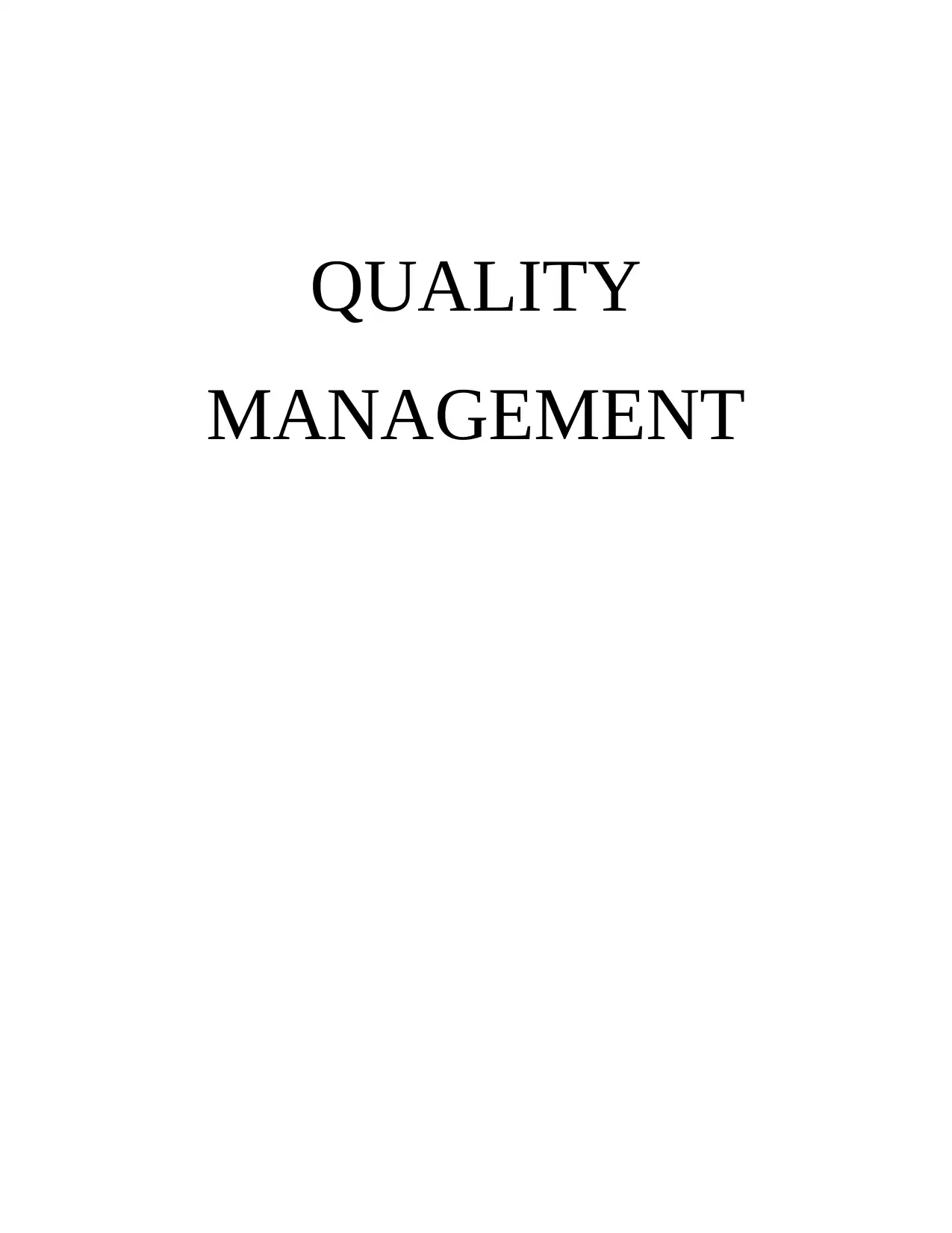
QUALITY
MANAGEMENT
MANAGEMENT
Paraphrase This Document
Need a fresh take? Get an instant paraphrase of this document with our AI Paraphraser
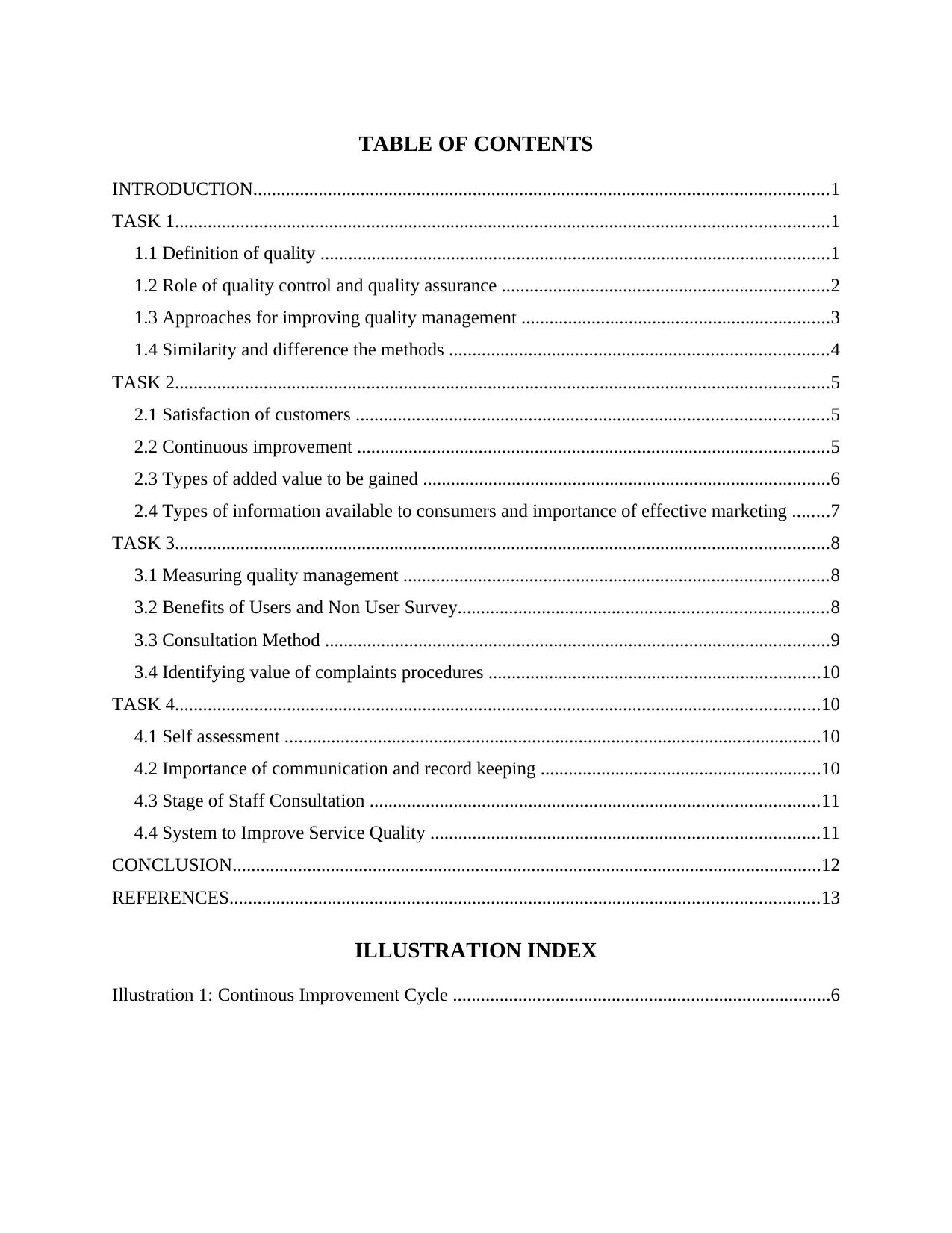
TABLE OF CONTENTS
INTRODUCTION...........................................................................................................................1
TASK 1............................................................................................................................................1
1.1 Definition of quality .............................................................................................................1
1.2 Role of quality control and quality assurance ......................................................................2
1.3 Approaches for improving quality management ..................................................................3
1.4 Similarity and difference the methods .................................................................................4
TASK 2............................................................................................................................................5
2.1 Satisfaction of customers .....................................................................................................5
2.2 Continuous improvement .....................................................................................................5
2.3 Types of added value to be gained .......................................................................................6
2.4 Types of information available to consumers and importance of effective marketing ........7
TASK 3............................................................................................................................................8
3.1 Measuring quality management ...........................................................................................8
3.2 Benefits of Users and Non User Survey...............................................................................8
3.3 Consultation Method ............................................................................................................9
3.4 Identifying value of complaints procedures .......................................................................10
TASK 4..........................................................................................................................................10
4.1 Self assessment ...................................................................................................................10
4.2 Importance of communication and record keeping ............................................................10
4.3 Stage of Staff Consultation ................................................................................................11
4.4 System to Improve Service Quality ...................................................................................11
CONCLUSION..............................................................................................................................12
REFERENCES..............................................................................................................................13
ILLUSTRATION INDEX
Illustration 1: Continous Improvement Cycle .................................................................................6
INTRODUCTION...........................................................................................................................1
TASK 1............................................................................................................................................1
1.1 Definition of quality .............................................................................................................1
1.2 Role of quality control and quality assurance ......................................................................2
1.3 Approaches for improving quality management ..................................................................3
1.4 Similarity and difference the methods .................................................................................4
TASK 2............................................................................................................................................5
2.1 Satisfaction of customers .....................................................................................................5
2.2 Continuous improvement .....................................................................................................5
2.3 Types of added value to be gained .......................................................................................6
2.4 Types of information available to consumers and importance of effective marketing ........7
TASK 3............................................................................................................................................8
3.1 Measuring quality management ...........................................................................................8
3.2 Benefits of Users and Non User Survey...............................................................................8
3.3 Consultation Method ............................................................................................................9
3.4 Identifying value of complaints procedures .......................................................................10
TASK 4..........................................................................................................................................10
4.1 Self assessment ...................................................................................................................10
4.2 Importance of communication and record keeping ............................................................10
4.3 Stage of Staff Consultation ................................................................................................11
4.4 System to Improve Service Quality ...................................................................................11
CONCLUSION..............................................................................................................................12
REFERENCES..............................................................................................................................13
ILLUSTRATION INDEX
Illustration 1: Continous Improvement Cycle .................................................................................6

INTRODUCTION
Quality management is considered as the universal phenomenon which focuses on
providing better organizational services to its customers. Quality planning, control, assurance
and enhancement are the major components that helps business to achieve desired targets.
Effective quality management also assists business entity in developing hospitality reputation
and also focuses on improving the level of profitability and revenue of the organization. Now
days, quality has become one of the major attributes which is mostly demanded by the customers
(Sitki Ilk ayand Aslan, 2012). Considering this element is essential for business organization to
involve certain factors in their products or services so that more of the customers get attracted
towards it and business can achieve its goals and objectives.
In the context of gaining in depth knowledge of quality management, the present report
has been prepared on Rose and Crown hotel which is provided in the case study and the
mentioned company is facing number of problems. Further, by evaluating all the scenarios,
decision will be made regarding the hospitality services and its quality which managers need to
consider for surviving in the competitive environment. This report will also focus on the
definition of quality both in terms of service as well as business conditions.
TASK 1
1.1 Definition of quality
According to Rutledge (2009). “quality is termed as producing goods or providing
services as per the industry standards so that ultimate needs and requirement of customers can be
achieved effectively in the respect of products and services”. Further, in general terms quality
can be stated as a set of standards which helps in measuring and comparing the products of
different businesses working within similar industry. It also focuses on evaluating the degree of
excellence. In this context, quality is stated as features of varied goods and services that helps in
satisfying needs of consumers.
From the view point of American Society for Quality it can be stated as the subjective
term that helps each and every individual to define different terms regarding quality which
possess different meanings:
It states the different features of products and services that helps in satisfying the needs of
customers.
1
Quality management is considered as the universal phenomenon which focuses on
providing better organizational services to its customers. Quality planning, control, assurance
and enhancement are the major components that helps business to achieve desired targets.
Effective quality management also assists business entity in developing hospitality reputation
and also focuses on improving the level of profitability and revenue of the organization. Now
days, quality has become one of the major attributes which is mostly demanded by the customers
(Sitki Ilk ayand Aslan, 2012). Considering this element is essential for business organization to
involve certain factors in their products or services so that more of the customers get attracted
towards it and business can achieve its goals and objectives.
In the context of gaining in depth knowledge of quality management, the present report
has been prepared on Rose and Crown hotel which is provided in the case study and the
mentioned company is facing number of problems. Further, by evaluating all the scenarios,
decision will be made regarding the hospitality services and its quality which managers need to
consider for surviving in the competitive environment. This report will also focus on the
definition of quality both in terms of service as well as business conditions.
TASK 1
1.1 Definition of quality
According to Rutledge (2009). “quality is termed as producing goods or providing
services as per the industry standards so that ultimate needs and requirement of customers can be
achieved effectively in the respect of products and services”. Further, in general terms quality
can be stated as a set of standards which helps in measuring and comparing the products of
different businesses working within similar industry. It also focuses on evaluating the degree of
excellence. In this context, quality is stated as features of varied goods and services that helps in
satisfying needs of consumers.
From the view point of American Society for Quality it can be stated as the subjective
term that helps each and every individual to define different terms regarding quality which
possess different meanings:
It states the different features of products and services that helps in satisfying the needs of
customers.
1
⊘ This is a preview!⊘
Do you want full access?
Subscribe today to unlock all pages.

Trusted by 1+ million students worldwide
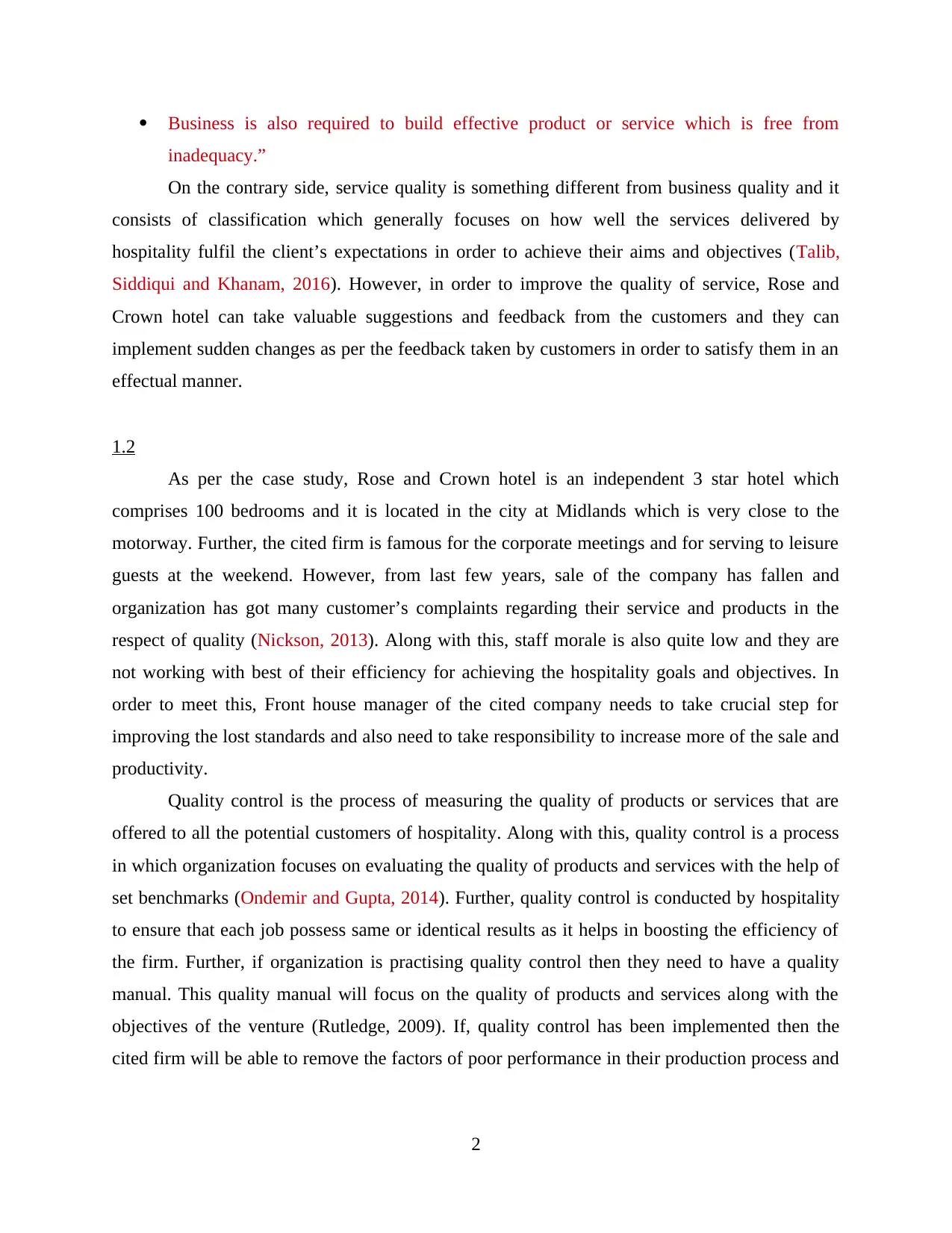
Business is also required to build effective product or service which is free from
inadequacy.”
On the contrary side, service quality is something different from business quality and it
consists of classification which generally focuses on how well the services delivered by
hospitality fulfil the client’s expectations in order to achieve their aims and objectives (Talib,
Siddiqui and Khanam, 2016). However, in order to improve the quality of service, Rose and
Crown hotel can take valuable suggestions and feedback from the customers and they can
implement sudden changes as per the feedback taken by customers in order to satisfy them in an
effectual manner.
1.2
As per the case study, Rose and Crown hotel is an independent 3 star hotel which
comprises 100 bedrooms and it is located in the city at Midlands which is very close to the
motorway. Further, the cited firm is famous for the corporate meetings and for serving to leisure
guests at the weekend. However, from last few years, sale of the company has fallen and
organization has got many customer’s complaints regarding their service and products in the
respect of quality (Nickson, 2013). Along with this, staff morale is also quite low and they are
not working with best of their efficiency for achieving the hospitality goals and objectives. In
order to meet this, Front house manager of the cited company needs to take crucial step for
improving the lost standards and also need to take responsibility to increase more of the sale and
productivity.
Quality control is the process of measuring the quality of products or services that are
offered to all the potential customers of hospitality. Along with this, quality control is a process
in which organization focuses on evaluating the quality of products and services with the help of
set benchmarks (Ondemir and Gupta, 2014). Further, quality control is conducted by hospitality
to ensure that each job possess same or identical results as it helps in boosting the efficiency of
the firm. Further, if organization is practising quality control then they need to have a quality
manual. This quality manual will focus on the quality of products and services along with the
objectives of the venture (Rutledge, 2009). If, quality control has been implemented then the
cited firm will be able to remove the factors of poor performance in their production process and
2
inadequacy.”
On the contrary side, service quality is something different from business quality and it
consists of classification which generally focuses on how well the services delivered by
hospitality fulfil the client’s expectations in order to achieve their aims and objectives (Talib,
Siddiqui and Khanam, 2016). However, in order to improve the quality of service, Rose and
Crown hotel can take valuable suggestions and feedback from the customers and they can
implement sudden changes as per the feedback taken by customers in order to satisfy them in an
effectual manner.
1.2
As per the case study, Rose and Crown hotel is an independent 3 star hotel which
comprises 100 bedrooms and it is located in the city at Midlands which is very close to the
motorway. Further, the cited firm is famous for the corporate meetings and for serving to leisure
guests at the weekend. However, from last few years, sale of the company has fallen and
organization has got many customer’s complaints regarding their service and products in the
respect of quality (Nickson, 2013). Along with this, staff morale is also quite low and they are
not working with best of their efficiency for achieving the hospitality goals and objectives. In
order to meet this, Front house manager of the cited company needs to take crucial step for
improving the lost standards and also need to take responsibility to increase more of the sale and
productivity.
Quality control is the process of measuring the quality of products or services that are
offered to all the potential customers of hospitality. Along with this, quality control is a process
in which organization focuses on evaluating the quality of products and services with the help of
set benchmarks (Ondemir and Gupta, 2014). Further, quality control is conducted by hospitality
to ensure that each job possess same or identical results as it helps in boosting the efficiency of
the firm. Further, if organization is practising quality control then they need to have a quality
manual. This quality manual will focus on the quality of products and services along with the
objectives of the venture (Rutledge, 2009). If, quality control has been implemented then the
cited firm will be able to remove the factors of poor performance in their production process and
2
Paraphrase This Document
Need a fresh take? Get an instant paraphrase of this document with our AI Paraphraser
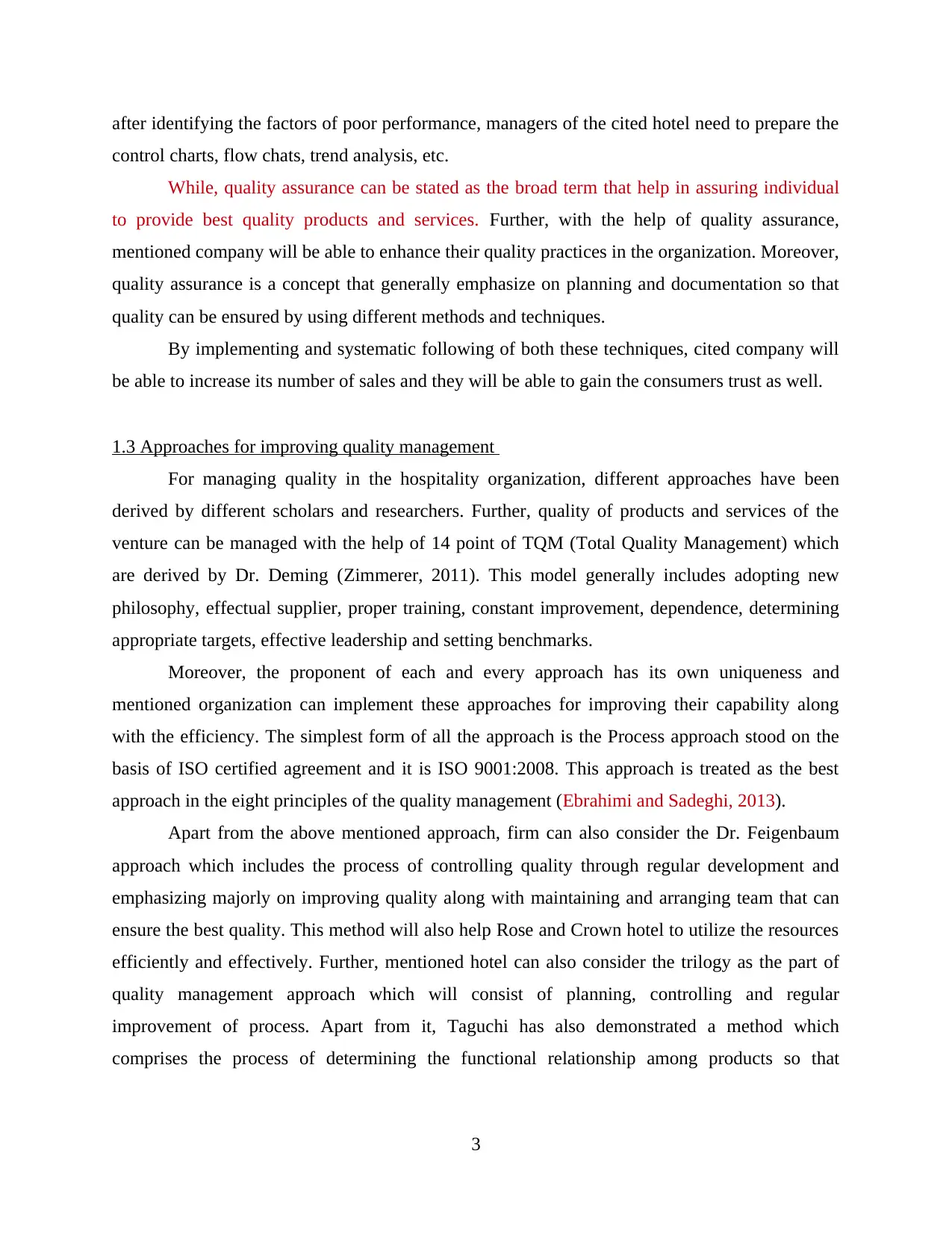
after identifying the factors of poor performance, managers of the cited hotel need to prepare the
control charts, flow chats, trend analysis, etc.
While, quality assurance can be stated as the broad term that help in assuring individual
to provide best quality products and services. Further, with the help of quality assurance,
mentioned company will be able to enhance their quality practices in the organization. Moreover,
quality assurance is a concept that generally emphasize on planning and documentation so that
quality can be ensured by using different methods and techniques.
By implementing and systematic following of both these techniques, cited company will
be able to increase its number of sales and they will be able to gain the consumers trust as well.
1.3 Approaches for improving quality management
For managing quality in the hospitality organization, different approaches have been
derived by different scholars and researchers. Further, quality of products and services of the
venture can be managed with the help of 14 point of TQM (Total Quality Management) which
are derived by Dr. Deming (Zimmerer, 2011). This model generally includes adopting new
philosophy, effectual supplier, proper training, constant improvement, dependence, determining
appropriate targets, effective leadership and setting benchmarks.
Moreover, the proponent of each and every approach has its own uniqueness and
mentioned organization can implement these approaches for improving their capability along
with the efficiency. The simplest form of all the approach is the Process approach stood on the
basis of ISO certified agreement and it is ISO 9001:2008. This approach is treated as the best
approach in the eight principles of the quality management (Ebrahimi and Sadeghi, 2013).
Apart from the above mentioned approach, firm can also consider the Dr. Feigenbaum
approach which includes the process of controlling quality through regular development and
emphasizing majorly on improving quality along with maintaining and arranging team that can
ensure the best quality. This method will also help Rose and Crown hotel to utilize the resources
efficiently and effectively. Further, mentioned hotel can also consider the trilogy as the part of
quality management approach which will consist of planning, controlling and regular
improvement of process. Apart from it, Taguchi has also demonstrated a method which
comprises the process of determining the functional relationship among products so that
3
control charts, flow chats, trend analysis, etc.
While, quality assurance can be stated as the broad term that help in assuring individual
to provide best quality products and services. Further, with the help of quality assurance,
mentioned company will be able to enhance their quality practices in the organization. Moreover,
quality assurance is a concept that generally emphasize on planning and documentation so that
quality can be ensured by using different methods and techniques.
By implementing and systematic following of both these techniques, cited company will
be able to increase its number of sales and they will be able to gain the consumers trust as well.
1.3 Approaches for improving quality management
For managing quality in the hospitality organization, different approaches have been
derived by different scholars and researchers. Further, quality of products and services of the
venture can be managed with the help of 14 point of TQM (Total Quality Management) which
are derived by Dr. Deming (Zimmerer, 2011). This model generally includes adopting new
philosophy, effectual supplier, proper training, constant improvement, dependence, determining
appropriate targets, effective leadership and setting benchmarks.
Moreover, the proponent of each and every approach has its own uniqueness and
mentioned organization can implement these approaches for improving their capability along
with the efficiency. The simplest form of all the approach is the Process approach stood on the
basis of ISO certified agreement and it is ISO 9001:2008. This approach is treated as the best
approach in the eight principles of the quality management (Ebrahimi and Sadeghi, 2013).
Apart from the above mentioned approach, firm can also consider the Dr. Feigenbaum
approach which includes the process of controlling quality through regular development and
emphasizing majorly on improving quality along with maintaining and arranging team that can
ensure the best quality. This method will also help Rose and Crown hotel to utilize the resources
efficiently and effectively. Further, mentioned hotel can also consider the trilogy as the part of
quality management approach which will consist of planning, controlling and regular
improvement of process. Apart from it, Taguchi has also demonstrated a method which
comprises the process of determining the functional relationship among products so that
3
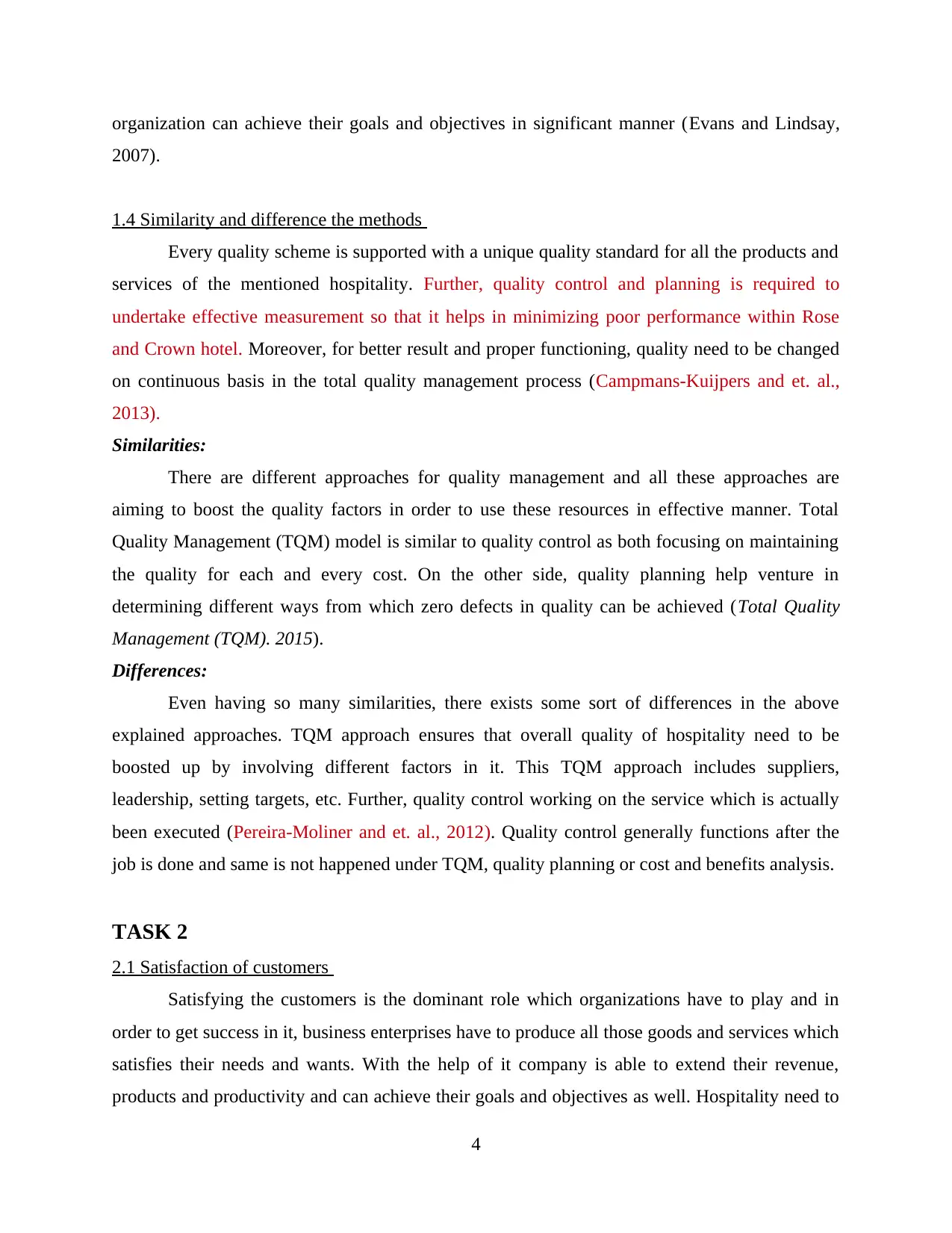
organization can achieve their goals and objectives in significant manner (Evans and Lindsay,
2007).
1.4 Similarity and difference the methods
Every quality scheme is supported with a unique quality standard for all the products and
services of the mentioned hospitality. Further, quality control and planning is required to
undertake effective measurement so that it helps in minimizing poor performance within Rose
and Crown hotel. Moreover, for better result and proper functioning, quality need to be changed
on continuous basis in the total quality management process (Campmans-Kuijpers and et. al.,
2013).
Similarities:
There are different approaches for quality management and all these approaches are
aiming to boost the quality factors in order to use these resources in effective manner. Total
Quality Management (TQM) model is similar to quality control as both focusing on maintaining
the quality for each and every cost. On the other side, quality planning help venture in
determining different ways from which zero defects in quality can be achieved (Total Quality
Management (TQM). 2015).
Differences:
Even having so many similarities, there exists some sort of differences in the above
explained approaches. TQM approach ensures that overall quality of hospitality need to be
boosted up by involving different factors in it. This TQM approach includes suppliers,
leadership, setting targets, etc. Further, quality control working on the service which is actually
been executed (Pereira-Moliner and et. al., 2012). Quality control generally functions after the
job is done and same is not happened under TQM, quality planning or cost and benefits analysis.
TASK 2
2.1 Satisfaction of customers
Satisfying the customers is the dominant role which organizations have to play and in
order to get success in it, business enterprises have to produce all those goods and services which
satisfies their needs and wants. With the help of it company is able to extend their revenue,
products and productivity and can achieve their goals and objectives as well. Hospitality need to
4
2007).
1.4 Similarity and difference the methods
Every quality scheme is supported with a unique quality standard for all the products and
services of the mentioned hospitality. Further, quality control and planning is required to
undertake effective measurement so that it helps in minimizing poor performance within Rose
and Crown hotel. Moreover, for better result and proper functioning, quality need to be changed
on continuous basis in the total quality management process (Campmans-Kuijpers and et. al.,
2013).
Similarities:
There are different approaches for quality management and all these approaches are
aiming to boost the quality factors in order to use these resources in effective manner. Total
Quality Management (TQM) model is similar to quality control as both focusing on maintaining
the quality for each and every cost. On the other side, quality planning help venture in
determining different ways from which zero defects in quality can be achieved (Total Quality
Management (TQM). 2015).
Differences:
Even having so many similarities, there exists some sort of differences in the above
explained approaches. TQM approach ensures that overall quality of hospitality need to be
boosted up by involving different factors in it. This TQM approach includes suppliers,
leadership, setting targets, etc. Further, quality control working on the service which is actually
been executed (Pereira-Moliner and et. al., 2012). Quality control generally functions after the
job is done and same is not happened under TQM, quality planning or cost and benefits analysis.
TASK 2
2.1 Satisfaction of customers
Satisfying the customers is the dominant role which organizations have to play and in
order to get success in it, business enterprises have to produce all those goods and services which
satisfies their needs and wants. With the help of it company is able to extend their revenue,
products and productivity and can achieve their goals and objectives as well. Hospitality need to
4
⊘ This is a preview!⊘
Do you want full access?
Subscribe today to unlock all pages.

Trusted by 1+ million students worldwide
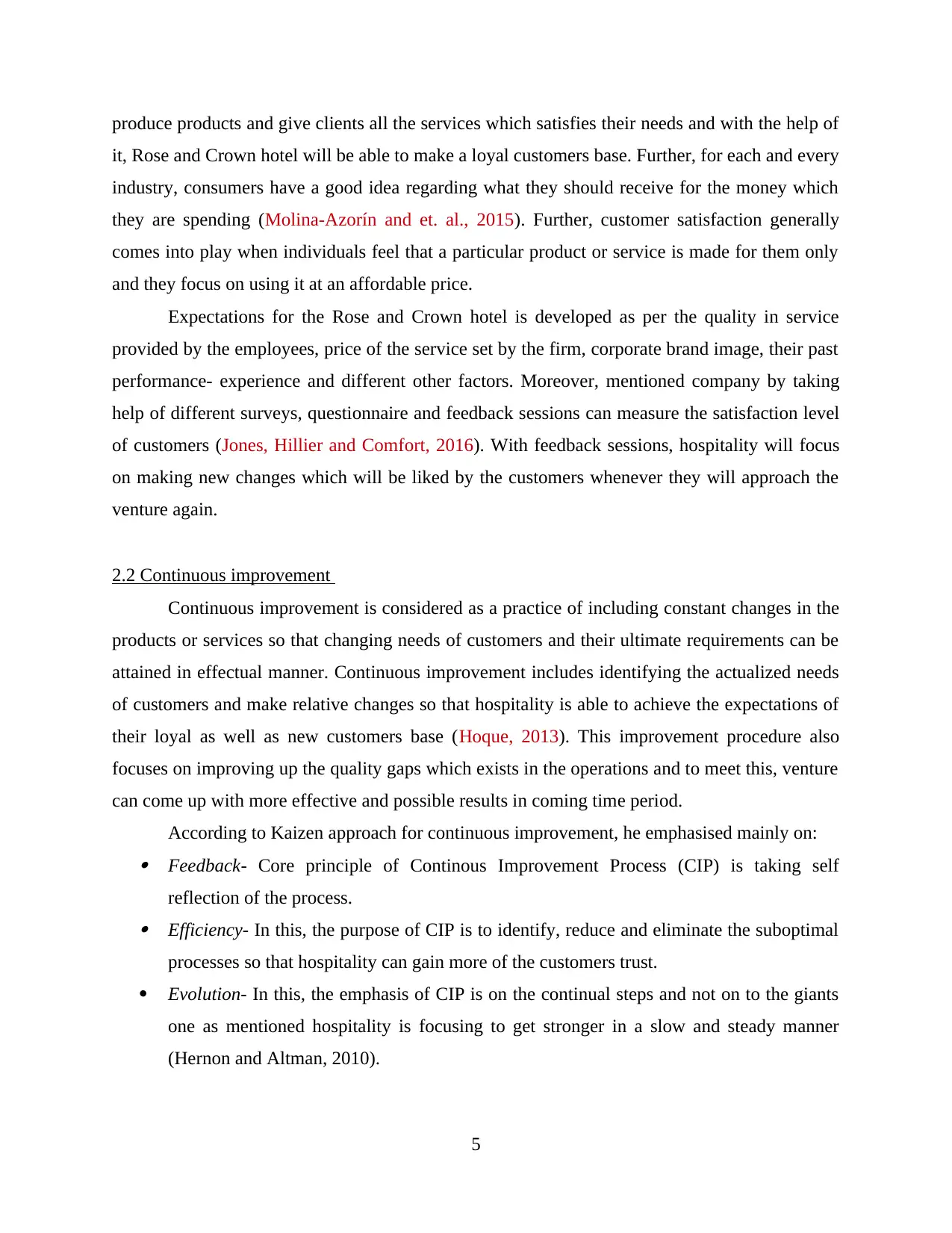
produce products and give clients all the services which satisfies their needs and with the help of
it, Rose and Crown hotel will be able to make a loyal customers base. Further, for each and every
industry, consumers have a good idea regarding what they should receive for the money which
they are spending (Molina-Azorín and et. al., 2015). Further, customer satisfaction generally
comes into play when individuals feel that a particular product or service is made for them only
and they focus on using it at an affordable price.
Expectations for the Rose and Crown hotel is developed as per the quality in service
provided by the employees, price of the service set by the firm, corporate brand image, their past
performance- experience and different other factors. Moreover, mentioned company by taking
help of different surveys, questionnaire and feedback sessions can measure the satisfaction level
of customers (Jones, Hillier and Comfort, 2016). With feedback sessions, hospitality will focus
on making new changes which will be liked by the customers whenever they will approach the
venture again.
2.2 Continuous improvement
Continuous improvement is considered as a practice of including constant changes in the
products or services so that changing needs of customers and their ultimate requirements can be
attained in effectual manner. Continuous improvement includes identifying the actualized needs
of customers and make relative changes so that hospitality is able to achieve the expectations of
their loyal as well as new customers base (Hoque, 2013). This improvement procedure also
focuses on improving up the quality gaps which exists in the operations and to meet this, venture
can come up with more effective and possible results in coming time period.
According to Kaizen approach for continuous improvement, he emphasised mainly on: Feedback- Core principle of Continous Improvement Process (CIP) is taking self
reflection of the process. Efficiency- In this, the purpose of CIP is to identify, reduce and eliminate the suboptimal
processes so that hospitality can gain more of the customers trust.
Evolution- In this, the emphasis of CIP is on the continual steps and not on to the giants
one as mentioned hospitality is focusing to get stronger in a slow and steady manner
(Hernon and Altman, 2010).
5
it, Rose and Crown hotel will be able to make a loyal customers base. Further, for each and every
industry, consumers have a good idea regarding what they should receive for the money which
they are spending (Molina-Azorín and et. al., 2015). Further, customer satisfaction generally
comes into play when individuals feel that a particular product or service is made for them only
and they focus on using it at an affordable price.
Expectations for the Rose and Crown hotel is developed as per the quality in service
provided by the employees, price of the service set by the firm, corporate brand image, their past
performance- experience and different other factors. Moreover, mentioned company by taking
help of different surveys, questionnaire and feedback sessions can measure the satisfaction level
of customers (Jones, Hillier and Comfort, 2016). With feedback sessions, hospitality will focus
on making new changes which will be liked by the customers whenever they will approach the
venture again.
2.2 Continuous improvement
Continuous improvement is considered as a practice of including constant changes in the
products or services so that changing needs of customers and their ultimate requirements can be
attained in effectual manner. Continuous improvement includes identifying the actualized needs
of customers and make relative changes so that hospitality is able to achieve the expectations of
their loyal as well as new customers base (Hoque, 2013). This improvement procedure also
focuses on improving up the quality gaps which exists in the operations and to meet this, venture
can come up with more effective and possible results in coming time period.
According to Kaizen approach for continuous improvement, he emphasised mainly on: Feedback- Core principle of Continous Improvement Process (CIP) is taking self
reflection of the process. Efficiency- In this, the purpose of CIP is to identify, reduce and eliminate the suboptimal
processes so that hospitality can gain more of the customers trust.
Evolution- In this, the emphasis of CIP is on the continual steps and not on to the giants
one as mentioned hospitality is focusing to get stronger in a slow and steady manner
(Hernon and Altman, 2010).
5
Paraphrase This Document
Need a fresh take? Get an instant paraphrase of this document with our AI Paraphraser
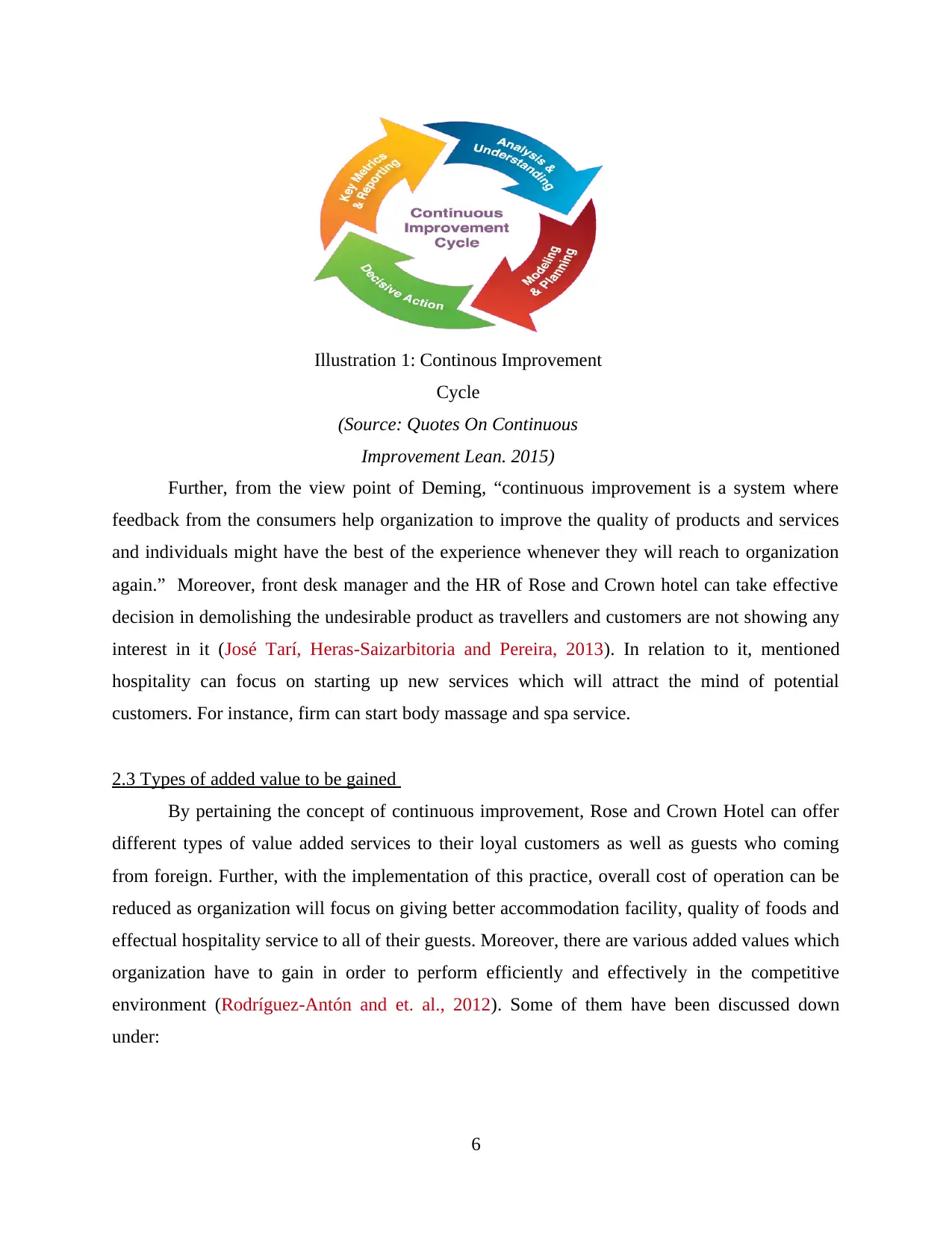
Illustration 1: Continous Improvement
Cycle
(Source: Quotes On Continuous
Improvement Lean. 2015)
Further, from the view point of Deming, “continuous improvement is a system where
feedback from the consumers help organization to improve the quality of products and services
and individuals might have the best of the experience whenever they will reach to organization
again.” Moreover, front desk manager and the HR of Rose and Crown hotel can take effective
decision in demolishing the undesirable product as travellers and customers are not showing any
interest in it (José Tarí, Heras-Saizarbitoria and Pereira, 2013). In relation to it, mentioned
hospitality can focus on starting up new services which will attract the mind of potential
customers. For instance, firm can start body massage and spa service.
2.3 Types of added value to be gained
By pertaining the concept of continuous improvement, Rose and Crown Hotel can offer
different types of value added services to their loyal customers as well as guests who coming
from foreign. Further, with the implementation of this practice, overall cost of operation can be
reduced as organization will focus on giving better accommodation facility, quality of foods and
effectual hospitality service to all of their guests. Moreover, there are various added values which
organization have to gain in order to perform efficiently and effectively in the competitive
environment (Rodríguez-Antón and et. al., 2012). Some of them have been discussed down
under:
6
Cycle
(Source: Quotes On Continuous
Improvement Lean. 2015)
Further, from the view point of Deming, “continuous improvement is a system where
feedback from the consumers help organization to improve the quality of products and services
and individuals might have the best of the experience whenever they will reach to organization
again.” Moreover, front desk manager and the HR of Rose and Crown hotel can take effective
decision in demolishing the undesirable product as travellers and customers are not showing any
interest in it (José Tarí, Heras-Saizarbitoria and Pereira, 2013). In relation to it, mentioned
hospitality can focus on starting up new services which will attract the mind of potential
customers. For instance, firm can start body massage and spa service.
2.3 Types of added value to be gained
By pertaining the concept of continuous improvement, Rose and Crown Hotel can offer
different types of value added services to their loyal customers as well as guests who coming
from foreign. Further, with the implementation of this practice, overall cost of operation can be
reduced as organization will focus on giving better accommodation facility, quality of foods and
effectual hospitality service to all of their guests. Moreover, there are various added values which
organization have to gain in order to perform efficiently and effectively in the competitive
environment (Rodríguez-Antón and et. al., 2012). Some of them have been discussed down
under:
6
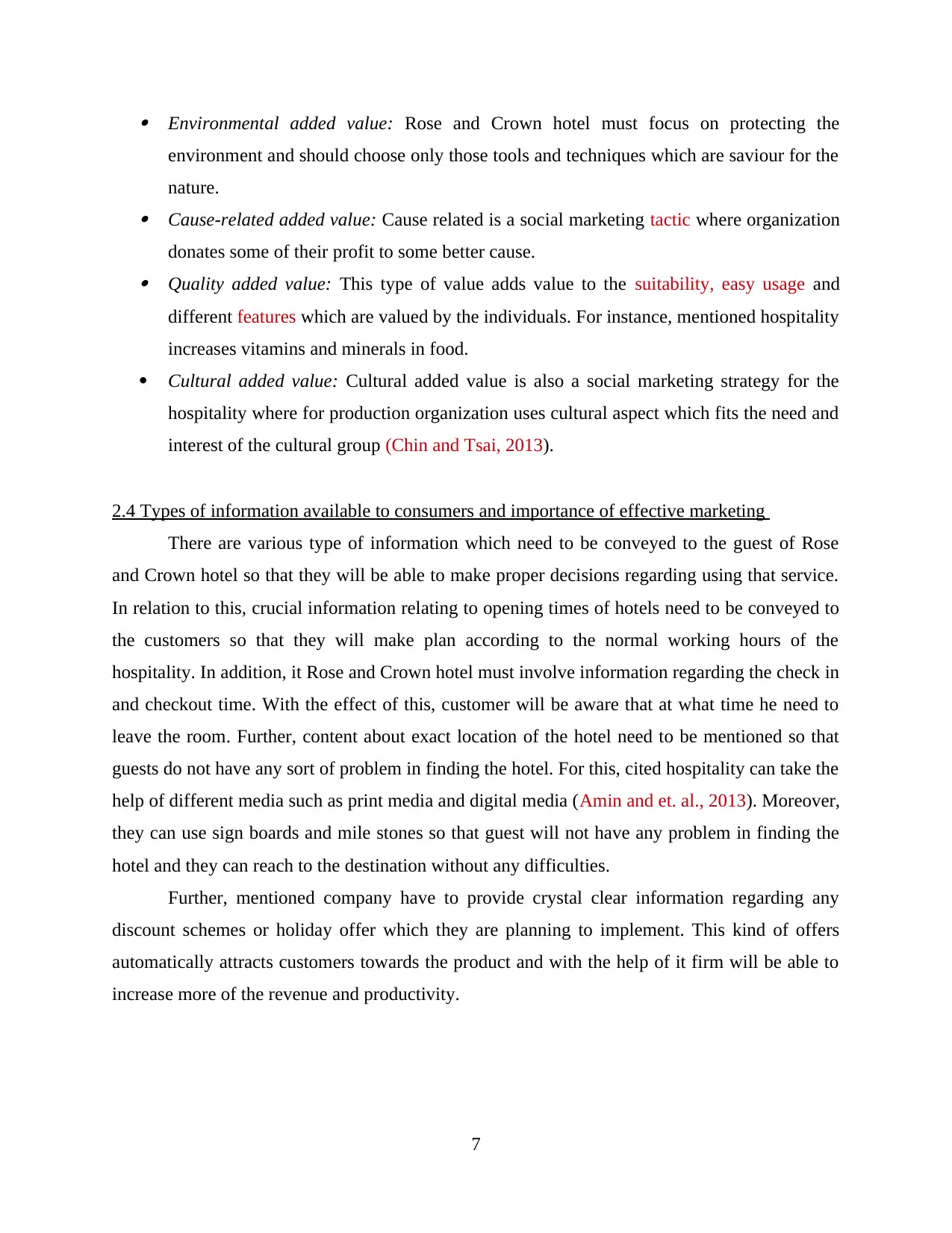
Environmental added value: Rose and Crown hotel must focus on protecting the
environment and should choose only those tools and techniques which are saviour for the
nature. Cause-related added value: Cause related is a social marketing tactic where organization
donates some of their profit to some better cause. Quality added value: This type of value adds value to the suitability, easy usage and
different features which are valued by the individuals. For instance, mentioned hospitality
increases vitamins and minerals in food.
Cultural added value: Cultural added value is also a social marketing strategy for the
hospitality where for production organization uses cultural aspect which fits the need and
interest of the cultural group (Chin and Tsai, 2013).
2.4 Types of information available to consumers and importance of effective marketing
There are various type of information which need to be conveyed to the guest of Rose
and Crown hotel so that they will be able to make proper decisions regarding using that service.
In relation to this, crucial information relating to opening times of hotels need to be conveyed to
the customers so that they will make plan according to the normal working hours of the
hospitality. In addition, it Rose and Crown hotel must involve information regarding the check in
and checkout time. With the effect of this, customer will be aware that at what time he need to
leave the room. Further, content about exact location of the hotel need to be mentioned so that
guests do not have any sort of problem in finding the hotel. For this, cited hospitality can take the
help of different media such as print media and digital media (Amin and et. al., 2013). Moreover,
they can use sign boards and mile stones so that guest will not have any problem in finding the
hotel and they can reach to the destination without any difficulties.
Further, mentioned company have to provide crystal clear information regarding any
discount schemes or holiday offer which they are planning to implement. This kind of offers
automatically attracts customers towards the product and with the help of it firm will be able to
increase more of the revenue and productivity.
7
environment and should choose only those tools and techniques which are saviour for the
nature. Cause-related added value: Cause related is a social marketing tactic where organization
donates some of their profit to some better cause. Quality added value: This type of value adds value to the suitability, easy usage and
different features which are valued by the individuals. For instance, mentioned hospitality
increases vitamins and minerals in food.
Cultural added value: Cultural added value is also a social marketing strategy for the
hospitality where for production organization uses cultural aspect which fits the need and
interest of the cultural group (Chin and Tsai, 2013).
2.4 Types of information available to consumers and importance of effective marketing
There are various type of information which need to be conveyed to the guest of Rose
and Crown hotel so that they will be able to make proper decisions regarding using that service.
In relation to this, crucial information relating to opening times of hotels need to be conveyed to
the customers so that they will make plan according to the normal working hours of the
hospitality. In addition, it Rose and Crown hotel must involve information regarding the check in
and checkout time. With the effect of this, customer will be aware that at what time he need to
leave the room. Further, content about exact location of the hotel need to be mentioned so that
guests do not have any sort of problem in finding the hotel. For this, cited hospitality can take the
help of different media such as print media and digital media (Amin and et. al., 2013). Moreover,
they can use sign boards and mile stones so that guest will not have any problem in finding the
hotel and they can reach to the destination without any difficulties.
Further, mentioned company have to provide crystal clear information regarding any
discount schemes or holiday offer which they are planning to implement. This kind of offers
automatically attracts customers towards the product and with the help of it firm will be able to
increase more of the revenue and productivity.
7
⊘ This is a preview!⊘
Do you want full access?
Subscribe today to unlock all pages.

Trusted by 1+ million students worldwide
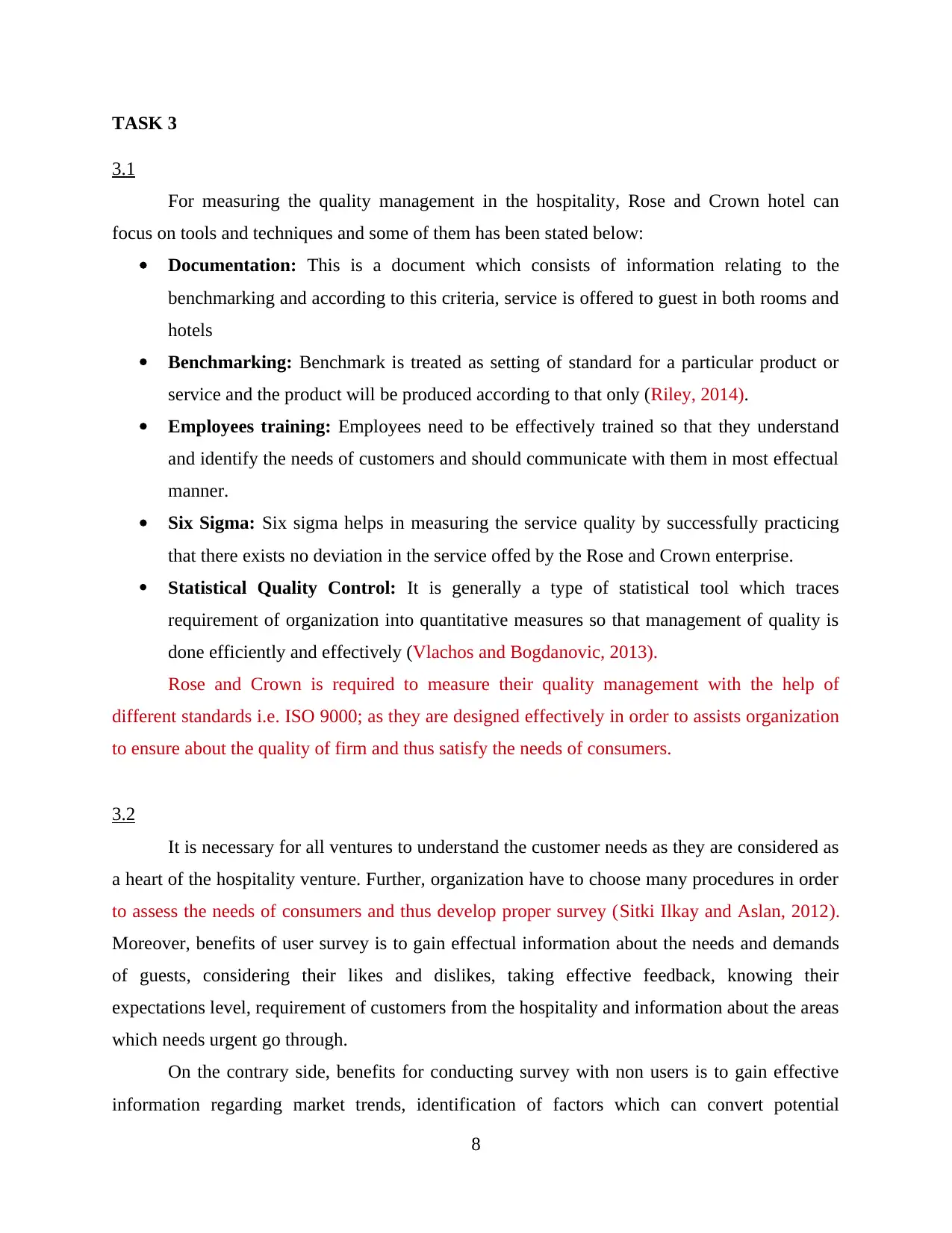
TASK 3
3.1
For measuring the quality management in the hospitality, Rose and Crown hotel can
focus on tools and techniques and some of them has been stated below:
Documentation: This is a document which consists of information relating to the
benchmarking and according to this criteria, service is offered to guest in both rooms and
hotels
Benchmarking: Benchmark is treated as setting of standard for a particular product or
service and the product will be produced according to that only (Riley, 2014).
Employees training: Employees need to be effectively trained so that they understand
and identify the needs of customers and should communicate with them in most effectual
manner.
Six Sigma: Six sigma helps in measuring the service quality by successfully practicing
that there exists no deviation in the service offed by the Rose and Crown enterprise.
Statistical Quality Control: It is generally a type of statistical tool which traces
requirement of organization into quantitative measures so that management of quality is
done efficiently and effectively (Vlachos and Bogdanovic, 2013).
Rose and Crown is required to measure their quality management with the help of
different standards i.e. ISO 9000; as they are designed effectively in order to assists organization
to ensure about the quality of firm and thus satisfy the needs of consumers.
3.2
It is necessary for all ventures to understand the customer needs as they are considered as
a heart of the hospitality venture. Further, organization have to choose many procedures in order
to assess the needs of consumers and thus develop proper survey (Sitki Ilkay and Aslan, 2012).
Moreover, benefits of user survey is to gain effectual information about the needs and demands
of guests, considering their likes and dislikes, taking effective feedback, knowing their
expectations level, requirement of customers from the hospitality and information about the areas
which needs urgent go through.
On the contrary side, benefits for conducting survey with non users is to gain effective
information regarding market trends, identification of factors which can convert potential
8
3.1
For measuring the quality management in the hospitality, Rose and Crown hotel can
focus on tools and techniques and some of them has been stated below:
Documentation: This is a document which consists of information relating to the
benchmarking and according to this criteria, service is offered to guest in both rooms and
hotels
Benchmarking: Benchmark is treated as setting of standard for a particular product or
service and the product will be produced according to that only (Riley, 2014).
Employees training: Employees need to be effectively trained so that they understand
and identify the needs of customers and should communicate with them in most effectual
manner.
Six Sigma: Six sigma helps in measuring the service quality by successfully practicing
that there exists no deviation in the service offed by the Rose and Crown enterprise.
Statistical Quality Control: It is generally a type of statistical tool which traces
requirement of organization into quantitative measures so that management of quality is
done efficiently and effectively (Vlachos and Bogdanovic, 2013).
Rose and Crown is required to measure their quality management with the help of
different standards i.e. ISO 9000; as they are designed effectively in order to assists organization
to ensure about the quality of firm and thus satisfy the needs of consumers.
3.2
It is necessary for all ventures to understand the customer needs as they are considered as
a heart of the hospitality venture. Further, organization have to choose many procedures in order
to assess the needs of consumers and thus develop proper survey (Sitki Ilkay and Aslan, 2012).
Moreover, benefits of user survey is to gain effectual information about the needs and demands
of guests, considering their likes and dislikes, taking effective feedback, knowing their
expectations level, requirement of customers from the hospitality and information about the areas
which needs urgent go through.
On the contrary side, benefits for conducting survey with non users is to gain effective
information regarding market trends, identification of factors which can convert potential
8
Paraphrase This Document
Need a fresh take? Get an instant paraphrase of this document with our AI Paraphraser
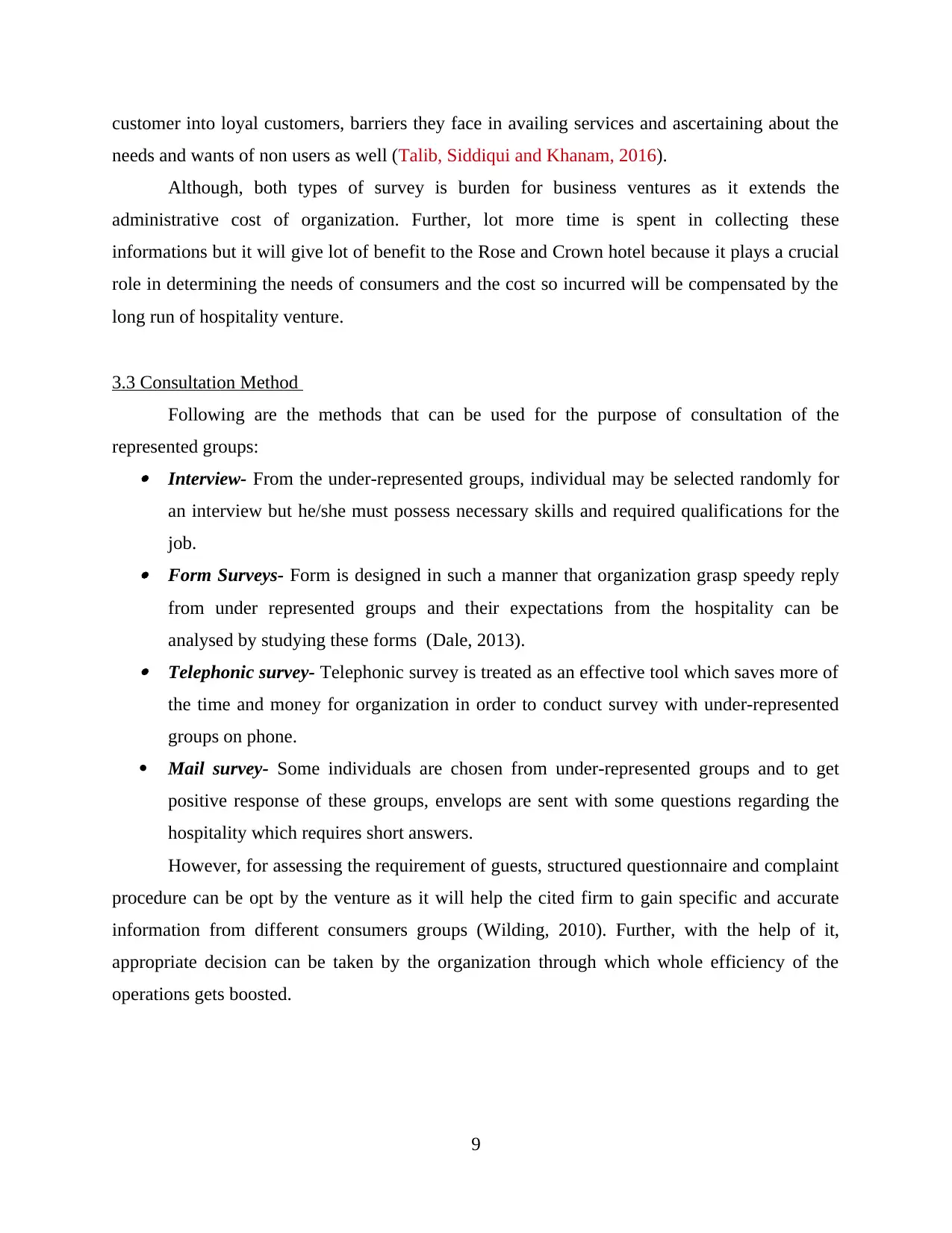
customer into loyal customers, barriers they face in availing services and ascertaining about the
needs and wants of non users as well (Talib, Siddiqui and Khanam, 2016).
Although, both types of survey is burden for business ventures as it extends the
administrative cost of organization. Further, lot more time is spent in collecting these
informations but it will give lot of benefit to the Rose and Crown hotel because it plays a crucial
role in determining the needs of consumers and the cost so incurred will be compensated by the
long run of hospitality venture.
3.3 Consultation Method
Following are the methods that can be used for the purpose of consultation of the
represented groups: Interview- From the under-represented groups, individual may be selected randomly for
an interview but he/she must possess necessary skills and required qualifications for the
job. Form Surveys- Form is designed in such a manner that organization grasp speedy reply
from under represented groups and their expectations from the hospitality can be
analysed by studying these forms (Dale, 2013). Telephonic survey- Telephonic survey is treated as an effective tool which saves more of
the time and money for organization in order to conduct survey with under-represented
groups on phone.
Mail survey- Some individuals are chosen from under-represented groups and to get
positive response of these groups, envelops are sent with some questions regarding the
hospitality which requires short answers.
However, for assessing the requirement of guests, structured questionnaire and complaint
procedure can be opt by the venture as it will help the cited firm to gain specific and accurate
information from different consumers groups (Wilding, 2010). Further, with the help of it,
appropriate decision can be taken by the organization through which whole efficiency of the
operations gets boosted.
9
needs and wants of non users as well (Talib, Siddiqui and Khanam, 2016).
Although, both types of survey is burden for business ventures as it extends the
administrative cost of organization. Further, lot more time is spent in collecting these
informations but it will give lot of benefit to the Rose and Crown hotel because it plays a crucial
role in determining the needs of consumers and the cost so incurred will be compensated by the
long run of hospitality venture.
3.3 Consultation Method
Following are the methods that can be used for the purpose of consultation of the
represented groups: Interview- From the under-represented groups, individual may be selected randomly for
an interview but he/she must possess necessary skills and required qualifications for the
job. Form Surveys- Form is designed in such a manner that organization grasp speedy reply
from under represented groups and their expectations from the hospitality can be
analysed by studying these forms (Dale, 2013). Telephonic survey- Telephonic survey is treated as an effective tool which saves more of
the time and money for organization in order to conduct survey with under-represented
groups on phone.
Mail survey- Some individuals are chosen from under-represented groups and to get
positive response of these groups, envelops are sent with some questions regarding the
hospitality which requires short answers.
However, for assessing the requirement of guests, structured questionnaire and complaint
procedure can be opt by the venture as it will help the cited firm to gain specific and accurate
information from different consumers groups (Wilding, 2010). Further, with the help of it,
appropriate decision can be taken by the organization through which whole efficiency of the
operations gets boosted.
9
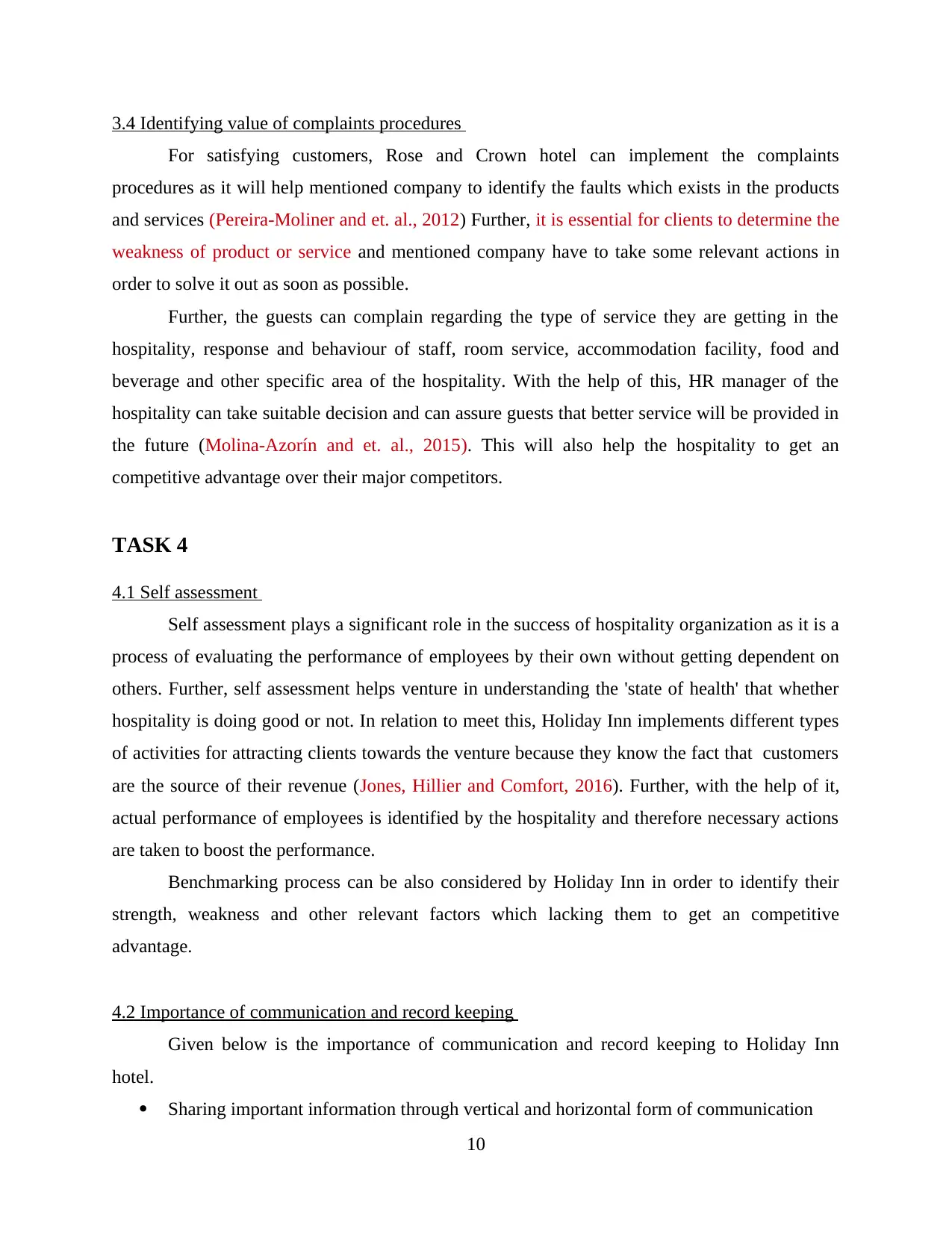
3.4 Identifying value of complaints procedures
For satisfying customers, Rose and Crown hotel can implement the complaints
procedures as it will help mentioned company to identify the faults which exists in the products
and services (Pereira-Moliner and et. al., 2012) Further, it is essential for clients to determine the
weakness of product or service and mentioned company have to take some relevant actions in
order to solve it out as soon as possible.
Further, the guests can complain regarding the type of service they are getting in the
hospitality, response and behaviour of staff, room service, accommodation facility, food and
beverage and other specific area of the hospitality. With the help of this, HR manager of the
hospitality can take suitable decision and can assure guests that better service will be provided in
the future (Molina-Azorín and et. al., 2015). This will also help the hospitality to get an
competitive advantage over their major competitors.
TASK 4
4.1 Self assessment
Self assessment plays a significant role in the success of hospitality organization as it is a
process of evaluating the performance of employees by their own without getting dependent on
others. Further, self assessment helps venture in understanding the 'state of health' that whether
hospitality is doing good or not. In relation to meet this, Holiday Inn implements different types
of activities for attracting clients towards the venture because they know the fact that customers
are the source of their revenue (Jones, Hillier and Comfort, 2016). Further, with the help of it,
actual performance of employees is identified by the hospitality and therefore necessary actions
are taken to boost the performance.
Benchmarking process can be also considered by Holiday Inn in order to identify their
strength, weakness and other relevant factors which lacking them to get an competitive
advantage.
4.2 Importance of communication and record keeping
Given below is the importance of communication and record keeping to Holiday Inn
hotel.
Sharing important information through vertical and horizontal form of communication
10
For satisfying customers, Rose and Crown hotel can implement the complaints
procedures as it will help mentioned company to identify the faults which exists in the products
and services (Pereira-Moliner and et. al., 2012) Further, it is essential for clients to determine the
weakness of product or service and mentioned company have to take some relevant actions in
order to solve it out as soon as possible.
Further, the guests can complain regarding the type of service they are getting in the
hospitality, response and behaviour of staff, room service, accommodation facility, food and
beverage and other specific area of the hospitality. With the help of this, HR manager of the
hospitality can take suitable decision and can assure guests that better service will be provided in
the future (Molina-Azorín and et. al., 2015). This will also help the hospitality to get an
competitive advantage over their major competitors.
TASK 4
4.1 Self assessment
Self assessment plays a significant role in the success of hospitality organization as it is a
process of evaluating the performance of employees by their own without getting dependent on
others. Further, self assessment helps venture in understanding the 'state of health' that whether
hospitality is doing good or not. In relation to meet this, Holiday Inn implements different types
of activities for attracting clients towards the venture because they know the fact that customers
are the source of their revenue (Jones, Hillier and Comfort, 2016). Further, with the help of it,
actual performance of employees is identified by the hospitality and therefore necessary actions
are taken to boost the performance.
Benchmarking process can be also considered by Holiday Inn in order to identify their
strength, weakness and other relevant factors which lacking them to get an competitive
advantage.
4.2 Importance of communication and record keeping
Given below is the importance of communication and record keeping to Holiday Inn
hotel.
Sharing important information through vertical and horizontal form of communication
10
⊘ This is a preview!⊘
Do you want full access?
Subscribe today to unlock all pages.

Trusted by 1+ million students worldwide
1 out of 16
Related Documents
Your All-in-One AI-Powered Toolkit for Academic Success.
+13062052269
info@desklib.com
Available 24*7 on WhatsApp / Email
![[object Object]](/_next/static/media/star-bottom.7253800d.svg)
Unlock your academic potential
Copyright © 2020–2025 A2Z Services. All Rights Reserved. Developed and managed by ZUCOL.





